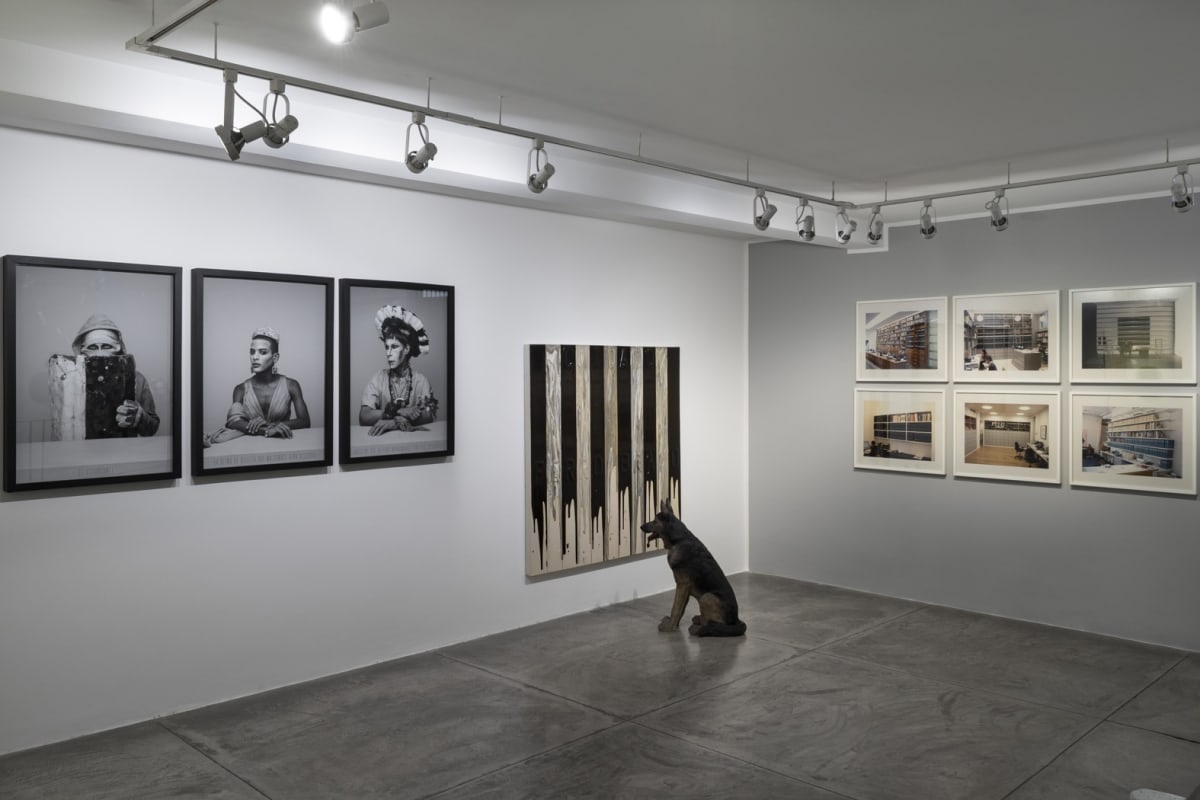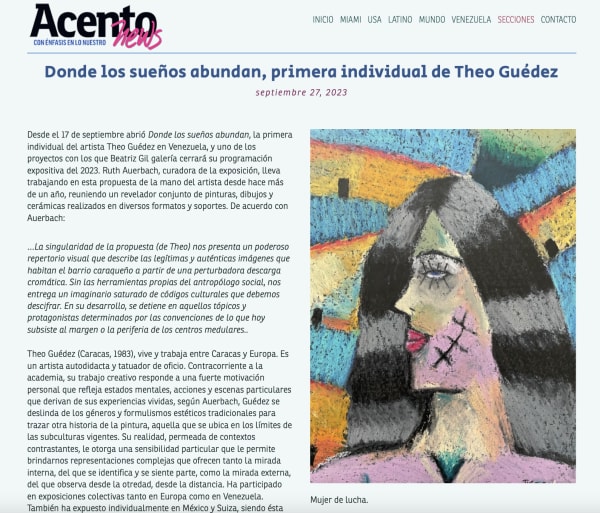Theo Guédez Venezuela, 1983
La vida en el barrio es un laberinto
Nace en Caracas ( 1983 ), Venezuela. Vive y trabaja entre Caracas y Europa. Artista autodidacta y tatuador. Su obra pictórica gira principalmente en torno a las subculturas y su entorno. Inspirándose en el Art Brut, concibe un lenguaje que señala distintas aristas y reflexiones visuales que van desde lo artístico a lo social y cultural, la idiosincrasia, el sincretismo latinoamericano, la ruptura del status quo y el sabor caribeño. Su trabajo creativo va a contracorriente de la academia, respondiendo a una fuerte motivación personal que refleja estados mentales, acciones y escenas particulares que se derivan de sus experiencias vividas.
Born in Caracas ( 1983 ), Venezuela. Lives and works between Caracas and Europe. Self-taught artist, graffiti and tattoo artist. His pictorial work revolves mainly around subcultures and their environment. Inspired by Art Brut, he conceives a language that points out different edges and visual reflections that go from the artistic to the social and cultural, the idiosyncrasy, the Latin American syncretism, the rupture of the status quo and the Caribbean flavor. His creative work goes against the current of academia, responding to a strong personal motivation that reflects states of mind, actions and particular scenes derived from his lived experiences.
La vida en el barrio es un laberinto, nos comenta Theo Guédez. Su propuesta pictórica se nos presenta así como una intrin-cada cartografía vernacular que retrata un territorio complejo, minado de tensiones internas —sociales y económicas—, a partir del cual el artista concibe una realidad distintiva y variopinta, centrada en un sistema de representación propio. Construida desde la contingente travesía del emigrado —que eventualmente retorna a sus orígenes—, su investigación visual atestigua una narrativa identitaria, anclada tanto en la memoria como en una noción abierta a la continua transformación de sus referentes.
Desde los inicios de su breve trayectoria, la práctica artística de Theo transita en su totalidad alrededor de la representación del barrio y su idiosincrasia cultural. Una reflexión vital que opera a partir del más honesto deseo por otorgarle visibilidad a los diversos sectores y vecindades, ubicados al margen de los centros urbanos. Theo nace y crece en el oeste de la ciudad de Caracas, entreLos Magallanes de Catia y el 23 de Enero. Los postulados de un urbanismo arquitectónico plenamente moderno que, finalmente, sucumbió al intento. En la actualidad, este circuito se caracteriza por una población multicultural que ejerce la actividad comercial e industrial a la par de una desbordada economía informal; un paisaje pluridimensional y caótico donde tambiénse manifiestan carencias de toda índole y se desata la arbitraria violencia, al ser este un territorio de circunstancias complejas y de condiciones sociales atrapadas en lo marginal.
Theo Guédez —artista autodidacta y tatuador de oficio—, establece su taller en la ciudad de Zúrich, Suiza. Allí emprende una acción creadora empírica y singular que da origen a un contundente cuerpo de trabajo cuyo proceso se nutre de experiencias personales, precisamente por la necesidad de recuperar una genealogía de historias, paisajes, retratos, costumbres y objetos comunes, atesorados en su archivo de memorias.
Cada imagen se constituye en documento gráfico que ocupa un lugar significante y simbólico en lo que pareciera próximo a una narrativa autobiográfica. En este compendio de imágenes, no se trata de idealizar el barrio, el proyecta realidades simultáneas y un sentimiento pleno de sensibilidad y emociones compartidas, pues su trabajo no se enuncia desde el trauma ni la herida: Theo le da «la vuelta» para mostrarnos el lado luminoso de esta narrativa.
La práctica de Theo Guédez se deslinda de los géneros y formulismos estéticos tradicionales para trazar otra historia de la pintura, aquella que se ubica en los límites de las subculturas vigentes. Su propuesta recoge referencias universales que bien podrían vin- cularse al Art Brut —término que Jean Dubuffet utilizó para designar las tendencias marginales a la cultura normalizada: arte ingenuo o popular—, como también al expresionismo picassiano, las perspectivas alteradas de Bárbaro Rivas, el simbolismo de Luis Méndez y la experiencia libérrima de Armando Reverón, artistas estos a quienes rinde su tributo.
Life in the neighborhood is a labyrinth, says Theo Guédez. His pictorial proposal is thus presented to us as an intricate vernacular cartography that portrays a complex territory, undermined by internal tensions -social and economic-, from which the artist conceives a distinctive and colorful reality, centered on a system of representation of his own. Constructed from the contingent journey of the emigrant -who eventually returns to his origins-, his visual research bears witness to an identity narrative, anchored both in memory and in a notion open to the continuous transformation of its referents.
Since the beginning of his brief career, Theo's artistic practice has revolved entirely around the representation of the neighborhood and its cultural idiosyncrasies. A vital reflection that operates from the most honest desire to give visibility to the various sectors and neighborhoods located on the margins of urban centers. Theo was born and grew up in the west of the city of Caracas, between Los Magallanes de Catia and 23 de Enero. The premises of a fully modern architectural urbanism that finally succumbed to the attempt. Today, this circuit is characterized by a multicultural population that exercises commercial and industrial activity alongside an overflowing informal economy; a multidimensional and chaotic landscape where shortages of all kinds are also manifested and arbitrary violence is unleashed, as this is a territory of complex circumstances and social conditions trapped in the marginal.
Theo Guédez -a self-taught artist and tattoo artist-, establishes his studio in the city of Zurich, Switzerland.
There he undertakes an empirical and singular creative action that gives rise to a forceful body of work whose process is nourished by personal experiences, precisely because of the need to recover a genealogy of stories, landscapes, portraits, customs and common objects, treasured in his archive of memories.
Each image becomes a graphic document that occupies a significant and symbolic place in what seems close to an autobiographical narrative. In this compendium of images, it is not about idealizing the neighborhood, he projects simultaneous realities and a feeling full of sensitivity and shared emotions, because his work is not expressed from the trauma or the wound: Theo "turns it around" to show us the luminous side of this narrative.
Theo Guédez's practice is detached from traditional genres and aesthetic formulisms to trace another history of painting, one that is located at the limits of current subcultures. His proposal gathers universal references that could well be linked to Art Brut -a term Jean Dubuffet used to designate the marginal tendencies to the normalized culture: naive or popular art-, as well as to Picasso's expressionism, the altered perspectives of Bárbaro Rivas, the symbolism of Luis Méndez and the free experience of Armando Reverón, artists to whom he pays tribute.
Ruth Auerbach
-

COLECTIVA_20 aniversario. El futuro está presente
16 artistas participantes 3 Noviembre 2024 - 10 Mayo 2025Colectiva celebratoria de nuestros 20 años con obras de 16 artistas latinoamericanos. Curaduría de Ruth Auerbach.Leer más -

Express
10 artistas participantes 25 Agosto - 20 Octubre 2024Colectiva Express bajo la curaduría y museografía de Jose Luis García. Una propuesta con 10 artistas venezolanos que nos han acompañado durante los 20 años de Beatriz Gil Galería.Leer más -

Donde los sueños abundan
Theo Guédez 17 Septiembre - 17 Diciembre 2023Exposición individual de Theo Guédez, "Donde los sueños abundan" , reúne pinturas, dibujos y cerámicas realizados en diversos formatos y soportes. Septiembre, 2024. Caracas, VenezuelaLeer más
-

Pinta Miami 2024
The contemporary latin american art show 5 - 8 Diciembre 2024Desde Beatriz Gil Galería y Victoria Art Gallery nos complace anunciar nuestra participación en Pinta Miami, la feria de arte contemporáneo latinoamericano que celebra su...Leer más -

Pinta Miami 2023
The modern and contemporary latin american art show 7 - 10 Diciembre 2023Pinta Miami celebra su decimoséptima iteración en 'El Hangar', el nuevo lugar en la comunidad artística de Coconut Grove. La Feria presenta el arte moderno...Leer más
-

PICAR LA TORTA de Manuela Zárate y la muestra colectiva EXPRESS en Beatriz Gil Galería
Estilo - Revista culturalNota de prensa, Artículo, Agosto 24, 2024 -

Centenarias exposiciones y cientas más
Revista EstiloInger Pedreáñez, Artículo, Marzo 31, 2024 -

Un año desbordado en arte (y 3)- Centenarias exposiciones y cientas más
Estilo - Revista CulturaInger Pedreáñez, Artículo, Marzo 31, 2024 -

Theo Guédez. Donde los sueños abundan
Papel Literario - El UniversalPapel Literario, Artículo, Febrero 25, 2024 -

Theo Guédez. Donde los sueños abundan Por Papel Literario
El NacionalRuth Auerbach, Artículo, Febrero 24, 2024 -

Donde los sueños abundan, primera individual de Theo Guédez
Acento NewsAcento News, Artículo, Septiembre 27, 2023














